Improvement in Food Resources Class 9 Notes Science Chapter 12
| Table of contents |

|
| Introduction |

|
| Enhancing Crop Yields |

|
| Crop Protection Management |

|
| Animal Husbandry |

|
| Bee-Keeping |

|
Introduction
Rising global population and heightened food demand necessitate an intricate study of food resource improvement. This imperative underscores the need for advancements in agricultural and animal husbandry practices to ensure sustainable food production.
Revolutionizing Food Resources
 Green RevolutionGreen Revolution
Green RevolutionGreen Revolution
1.A period of rapid increase in agricultural production in the mid-20th century.
2. Involved in the use of high-yielding varieties, fertilizers, and irrigation.
3.Improved global food security and reduced poverty. White Revolution
White Revolution
1. A movement to increase milk production in India during the 1970s.
2. Involved in improved dairy farming practices and cooperative marketing.
3. Resulted in India becoming one of the largest milk producers globally.
Enhancing Crop Yields
Successful Crop Production- Understand growth and development of crops.
- Factors: nutrients, climate, water.
- Focus on Kharif (June-October) and Rabi (November-April) seasons.
Crop Variety Improvement
- Through hybridization or gene introduction.
- Hybridization involves crossing genetically dissimilar plants.
- Gene introduction results in genetically modified crops.
Factors for Variety Improvement
- Higher yield
- Improved quality
- Biotic and abiotic resistance
- Change in maturity duration
- Wider adaptability
- Desirable agronomic characteristics
Crop Production Management
In India, similar to many other countries where agriculture is prominent, farming can vary from small-scale to large-scale operations.
- Vary based on land, financial resources, and technology.
- Levels: no-cost, low-cost, high-cost production practices.
i. Higher yield
ii. Improved quality
iii. Good appearance
iv. Disease resistance
v. More height
vi. Wider adaptability
Plant Nutrients
- Supplied by air, water, and soil.
- Sixteen essential nutrients for plants.
- Air: Carbon, Oxygen; Water: Hydrogen, Oxygen.
- Soil (Macro-nutrients): Nitrogen, Phosphorus, Potassium, Calcium, Magnesium, Sulphur.
- Soil (Micro-nutrients): Iron, Manganese, Boron, Zinc, Copper, Molybdenum, Chlorine.
Manure
- Contains organic matter and nutrients.
- Prepared by decomposing animal excreta and plant waste.
- Enriches soil and enhances fertility.
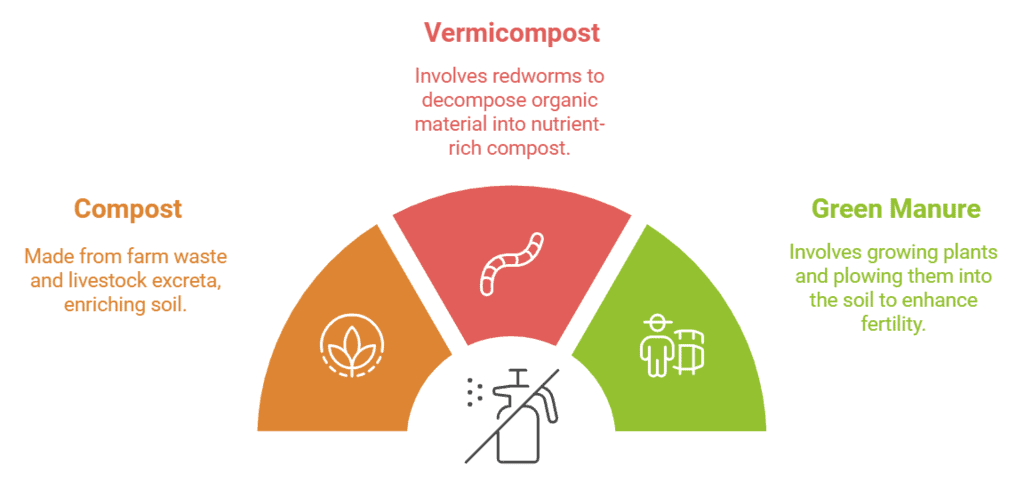 Types of Manure
Types of Manure
Fertilizers
- Commercially produced plant nutrients.
- Supply Nitrogen, Phosphorus, Potassium.
- Ensure vegetative growth, and healthy plants.
- Crucial for higher yields in high-cost farming.
Organic Farming
- Minimal or no use of chemicals.
- Emphasizes organic manures, and recycled farm-wastes.
- Utilizes bio-agents like blue-green algae for biofertilizers.
- Neem leaves or turmeric is used in grain storage as bio-pesticides.
- Promotes mixed cropping, inter-cropping, and crop rotation for insect, pest, and weed control, while providing nutrients.
Irrigation
Proper irrigation is very important for the success of crops. Ensuring that the crop gets water at the right stages during its growing season, can increase the expected yield of a crop.
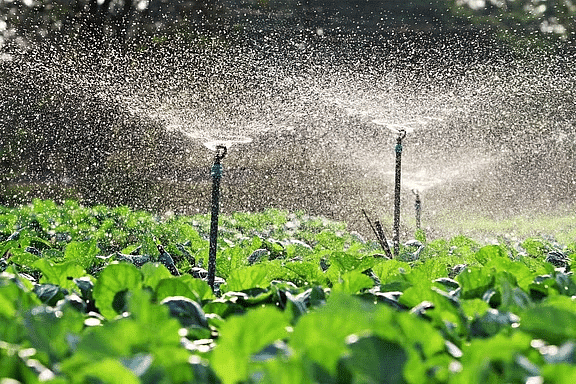 Irrigation
Irrigation
- Different kinds of irrigation systems include wells, canals, rivers and tanks.
(i) Wells:These are of two types namely dug wells and tube wells. In a dug well, water is collected from water-bearing strata. Tube wells can tap water from the deeper strata. From these wells, water is lifted by pumps for irrigation.
(ii) River lift system: In areas where canal flow is insufficient or irregular due to inadequate reservoir release, the lift system is more rational. Water is directly drawn from the rivers for supplementing irrigation in areas close to rivers.
(iii) Tanks: These are small storage reservoirs, which intercept and store the run-off of smaller catchment areas.
Cropping Patterns
It includes different ways of growing crops so as to get the maximum benefit. These different ways include the following:
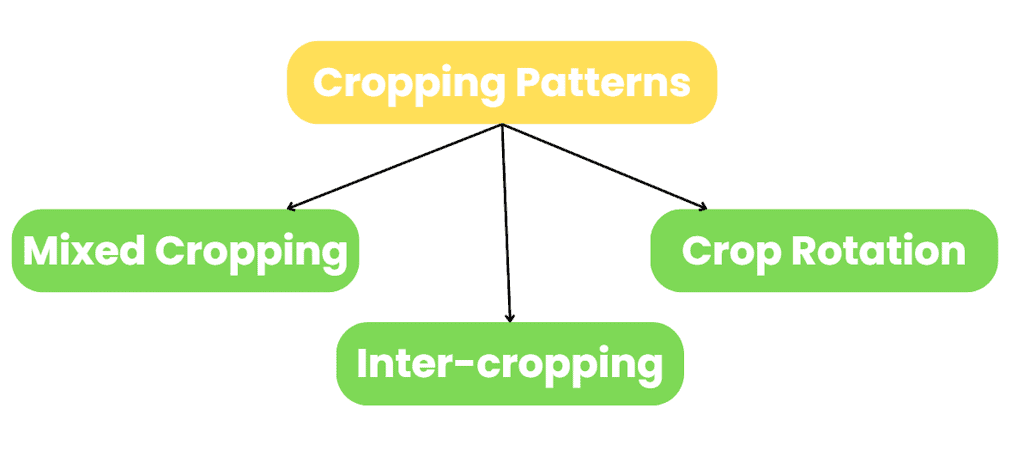
Mixed Cropping:
- Simultaneous cultivation of two or more crops on the same land.
- Example: Wheat + Gram, Wheat + Mustard, Groundnut + Sunflower.
- Reduces disease risk and provides insurance against crop failure.
Inter-cropping:
- Simultaneous cultivation of two or more crops in a defined pattern.
- Example: Soybean + Maize, Finger Millet (Bajra) + Cowpea (Lobia).
- Rows of one crop alternate with rows of another.
- Selected crops have different nutrient requirements.
- Maximizes nutrient utilization and prevents pests and diseases.
Crop Rotation:
- Growing different crops in a pre-planned succession on the same land.
- Duration-dependent rotations for various crop combinations.
- Moisture and irrigation availability influence crop choice.
- Proper rotation allows for two or three crops per year, ensuring a good harvest.
The food requirements of dairy animals are of two types:
(a) maintenance requirement which is the food required to support the animals to live a healthy life, and
(b)milk-producing requirement, which is the type of food required during the lactation period.
Crop Protection Management
Weeds: Unwanted plants such as Xanthium (Gokhroo), Parthenium (Gazar Ghas), and Cyperinus rotundus (Motha) pose a threat to cultivated fields. They compete with crops for essential resources—food, space, and light—resulting in nutrient uptake by weeds and reduced crop growth. Timely removal of weeds during the early stages of crop growth is crucial for ensuring a bountiful harvest.

Insect Pests: Insect pests pose a triple threat to plants by cutting roots, stems, and leaves; sucking cell sap from various plant parts; and boring into stems and fruits. These activities adversely impact crop health and lead to reduced yields.
Preventive Measures Against Pests
- Use of Disease-Resistant Varieties: Selecting plant varieties resistant to common diseases.
- Simultaneous Crop Growth: Growing two or more crops simultaneously on the same field can disrupt pest cycles.
- Summer Ploughing: Deep ploughing during summers serves a dual purpose, eliminating both pests and weeds, and contributing to a healthier crop.
Animal Husbandry
Animal husbandry is the scientific management of animal livestock. It includes various aspects such as feeding, breeding and disease control. Animal-based farming includes cattle, goat, sheep, poultry and fish farming.
Cattle Farming
- Milk-producing females are called milch animals (dairy animals), while the one used for farm labour is called draught animals.
- The animal feed includes:
(a) Roughage, which is large, fiber and
(b) Concentrates that are low in fiber and contain relatively high levels of protein and other nutrients.
Poultry Farming
Poultry farming focuses on breeding improved poultry breeds with specific traits. These include:
- Chick Quantity and Quality: Enhancing the reproductive capacity.
- Dwarf Broiler Parent: Aimed at commercial chick production.
- Summer Adaptation: Developing breeds resilient to summer conditions.
- Low Maintenance: Breeds requiring minimal upkeep.
- Reduced Size of Egg-Laying Birds: Adaptability to fibrous, cost-effective diets from agricultural by-products.
- Efficient production in poultry farming relies on meticulous management practices.
- This encompasses maintaining optimal temperature and hygiene in housing, ensuring quality poultry feed, and implementing effective measures for disease and pest prevention and control.
- Distinct requirements exist for broilers and egg layers, influencing aspects such as housing, nutrition, and the environment. Broiler diets emphasize protein-rich, adequately fatty rations, with elevated levels of vitamins A and K in poultry feeds.
Fish Production
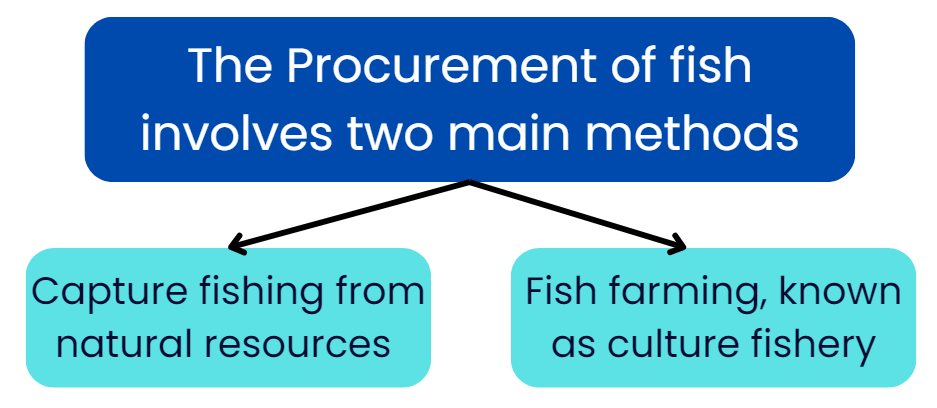
- Various marine fish varieties, including Pomphret, mackerel, tuna, sardines, and Bombay duck, hold popularity. Valuable marine species like mullets, bhetki, pearl spots, prawns, mussels, and oysters contribute significantly to the economy.
- With marine fish stocks depleting, the demand for fish is met through culture fisheries, specifically mariculture.
- Fish resources encompass freshwater and brackish water bodies, with composite fish culture systems allowing extensive farming through the strategic combination of different fish species in a single pond.
Bee-Keeping
- Beekeeping, an integral part of agriculture, centers around honey production. This low-investment enterprise serves as an additional income source for farmers.
- Beehives not only yield honey but also provide wax for medicinal purposes.
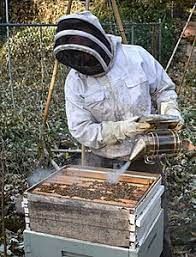
- Bee varieties for honey production include local types such as Apis cerana indica, A. dorsata, and A. florae, alongside the Italian bee variety (A. mellifera), introduced for increased honey yield.
- Italian bees are valued for their high honey collection capacity, minimal aggression, prolonged hive stay, and robust breeding capabilities.
- Commercial honey production is organized through bee farms or apiaries. Factors influencing honey quality include the availability of pasturage (flowers) for bees to collect nectar and pollen, along with the types of flowers in the vicinity.
- The taste of honey is intricately linked to the diversity and adequacyof pasturage.
|
84 videos|478 docs|60 tests
|
FAQs on Improvement in Food Resources Class 9 Notes Science Chapter 12
| 1. What are some effective methods for enhancing crop yields? |  |
| 2. How can crop protection management contribute to food security? |  |
| 3. What are the benefits of animal husbandry in improving food resources? |  |
| 4. Why is bee-keeping important for agriculture? |  |
| 5. What are some sustainable practices for improving food resources? |  |
















